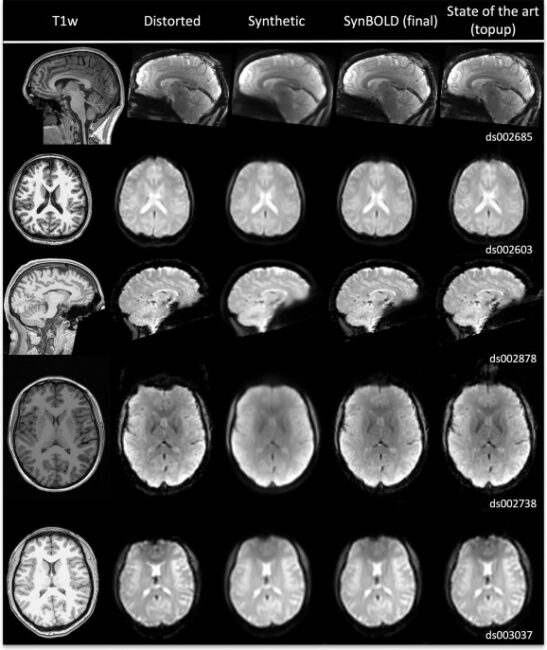Distortion correction of functional MRI without reverse phase encoding scans or field maps
Tian Yu, Leon Y. Cai, Salvatore Torrisi, An Thanh Vu, Victoria L. Morgan, Sarah E. Goodale, Karthik Ramadass, Steven L. Meisler, Jinglei Lv, Aaron E.L. Warren, Dario J. Englot, Laurie Cutting, Catie Chang, John C. Gore, Bennett A. Landman, Kurt G. Schilling
Paper: https://www.sciencedirect.com/science/article/pii/S0730725X23001121
Code: https://github.com/MASILab/SynBOLD-DisCo
Abstract
Functional magnetic resonance images (fMRI) acquired using echo planar sequences typically suffer from spatial distortions due to susceptibility induced off-resonance fields, which may cause geometric mismatch with structural images and affect subsequent quantification and localization of brain function. State-of-the art distortion correction methods (for example, using FSL’s topup or AFNI’s 3dQwarp algorithms) require the collection of additional scans – either field maps or images with reverse phase encoding directions (i.e., blip-up/blip-down acquisitions) – to estimate and correct distortions. However, not all imaging protocols acquire these additional data and thus cannot take advantage of these post-acquisition corrections. In this study, we aim to enable state-of-the art processing of historical or limited datasets that do not include specific sequences for distortion correction by using only the acquired functional data and a single commonly acquired structural image. To achieve this, we synthesize an undistorted image with contrast similar to the fMRI data and use the non-distorted synthetic image as an anatomical target for distortion correction. We evaluate the efficacy of this approach, named SynBOLD-DisCo (Synthetic BOLD contrast for Distortion Correction), and show that this distortion correction process yields fMRI data that are geometrically similar to non-distorted structural images, with distortion correction virtually equivalent to acquisitions that do contain both blip-up/blip-down images. Our method is available as a Singularity container, source code, and an executable trained model to facilitate evaluation and integration into existing fMRI preprocessing pipelines.
